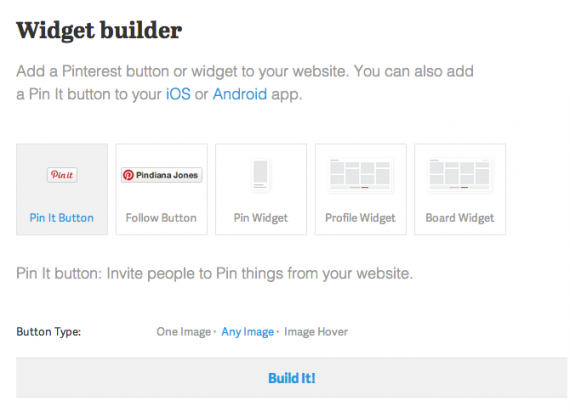The holiday season is upon us and merchants are looking for innovative ways to market their products. Pinterest is one of those ways.
Its emphasis on the use of visual imagery, combined with a quickly growing, active user base interested in purchasing products make it a highly suitable supplement to traditional ecommerce. It has reportedly eclipsed Twitter and closely follows Facebook in terms of social commerce sales.
Here are seven ways to use Pinterest to enhance holiday sales.
1. Add Pin It Buttons to Product Pages
Pinterest is best known for the amount of sharing among its users through repins. Encourage such activity by integrating Pin It buttons on product pages on your ecommerce site.

Pin It button as seen on an ecommerce website.
Many ecommerce platforms include this by default. But in the event yours does not, adding buttons is easy. Pinterest provides a widget builder to facilitate the process.

Pinterest widget builder makes it easy to create Pin It buttons.
Step 1: Choose the button style from the options listed.
Step 2: Select the button type. Three are available.
- One Image. Use this with a single product.
- Any Image. Include this in the page template for all products.
- Image Hover. This button appears when customers hover over a product image.
Step 3: Click “Build It!”
Step 4: Insert the HTML code that appears into your product page template.
Step 5: Add the JavaScript code just above the closing BODY tag.
(If you choose the “One Image” button type, you will also be required to add the product image, product page URL, and product description.)
2. Put User Interests First
Pinterest offers detailed analytics that help you see how many people are pinning from your website, seeing your Pins, and clicking your content. You can also see which Pins get shared most often, who interacts with them, and what else people add alongside them.

Pinterest analytics let merchants see data about pinned items.
This is useful for learning which of your products are most popular and can help you determine how to tailor Pinterest to best suit the interests of your followers.
3. Appeal to Customer Lifestyles
People use Pinterest to get ideas and inspiration for items that appeal to their lifestyle. As such, don’t just create product boards, but include those that relate the way they live. To quote Pinterest, “Instead of just showing off your products, show what inspires them. Create boards for the ideas, places, people and moods behind your brand.”
For example, John S Brana, a San Francisco-based designer of handmade gemstone jewelry, includes boards focused on gardening, clothes, fitness & health, and art.

John S Brana sells handmade jewelry using Pinterest.
Brana understands his customers well enough to know that these are appropriate to include alongside product boards. His approach is paying off too. His boards have received more than 1,300 likes and he has nearly 2,500 followers.
A good way to learn more about your customer’s lifestyles is by creating buyer personas that include demographic, lifestyle, and behavioral information. Personas are fictional characters that represent your target customer segments.
4. Repin from Other Sites
Repining is probably the most prominent activity conducted on Pinterest. So, don’t just pin your own content, but find relevant content pinned by others and share it on your boards.
This is beneficial for at least two reasons:
- It supplements your original content, thus enabling you to pin more often;
- It brings your page to the attention of the person you repinned from and they may return the favor.
Concentrate on finding the best pins that would interest and add value to your followers.
5. Use Search-friendly Titles and Descriptions
Pinterest is a platform for product discovery that is facilitated by its internal search function. One of the best ways to get your products found is by adding search-friendly titles and descriptions to boards and pinned items.
6. Create Holiday Gift Guides
One of the most difficult decisions people have to make during the holidays is what to buy for family and friends. Use Pinterest to solve that problem for them by setting up gift guides similar to what large retail brands like Urban Outfitters and Tiffany have done.

Tiffany holiday gift guide Pinterest board.
7. Use Rich Pins
Rich Pins add extra details to your product pins such as price, availability and where to buy.

Rich Pin data included on product pin.
In order to use Rich Pins, You will need to add meta tags to your website, test your Rich Pins and make application to get them included on Pinterest. This may require the assistance of a developer.
Two New Features
Pinterest recently announced two new features that should soon be available to all business users and are worth keeping an eye on:
- Promoted pins. Pinterest is experimenting with advertising in the form of promoted pins, which is similar to what both Facebook and Twitter offer. They work like regular pins, but include a special “promoted” label, along with a link to learn more about the pinned item. Pinterest has a web form that those interested can complete to be kept up to date on this development.
- Now-trending tool. According to The Wall Street Journal, Pinterest will allow partners such as Zappos and Walmart to use real-time Pinterest data to generate lists of the most-pinned items from their online stores. Though currently available only to certain partners, plans are to roll it out to all ecommerce sites in the future.




